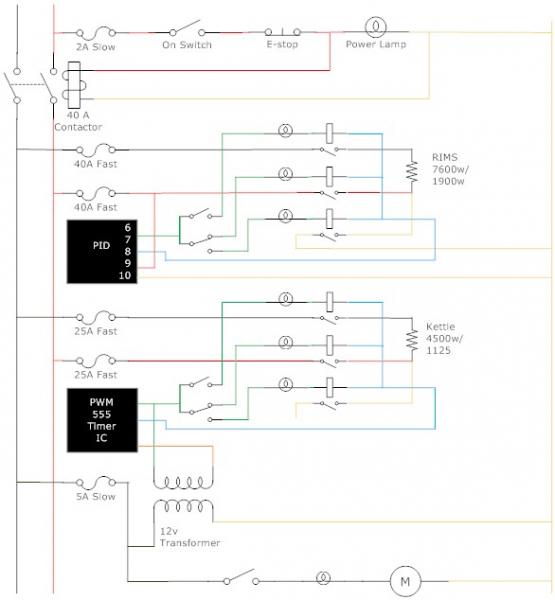MonkeyWrench
Well-Known Member
So, here's a schematic I recently made with the plans to build a 2 vessel RIMS system. The idea behind this is a compact system that still allows for full functionality and fly-sparging.
The system will use 2 Sanke kegs, 2 3800w HWD elements mounted in a copper RIMS tube, one pump, and a CFC.
The MLT and BK will both be tied to the inlet of the pump, then two valves on the outlet will direct the flow either to the RIMS tube and back into the MLT or through the CFC and into the BK.
Mashing will be standard RIMS pumped through the 2 3800w element tube that is switched to 120v, so only putting out 1900w. The sparging will be on-demand fly-sparge using city water pressure through the RIMS tube running on 240 and putting out 7600w. The runnings are pumped into the BK.
At this time, the BK can be heating the runnings on low (4500w element at 120v = 1125w) to conserve energy because the setup would need to be fed with a 60A GFCI panel, plus the contactor would need to be 60A as well, plus much heavier wiring, etc, equals a lot more money. Once sparging is done, the power is killed to the elements and pump, and the power is switched over on the BK element to high. I may incorporate some sort of safety devise or switch to make sure only one setup is running on high at any given time. Or, just get rid of the switching capability of the BK all together and only sparge, or only heat the BK. That would be one less thing to worry about (or go wrong).
The BK element will be run off of a 555 chip PWM board with a potentiometer. This way I can just turn it up or down as more or less heat is needed.
Please critique these plans and the drawing for issues, as I really don't know what I'm doing.
Here's the schematic. I can't get my PDF to attach, it's too big, so here's a lower quality JPG.

The system will use 2 Sanke kegs, 2 3800w HWD elements mounted in a copper RIMS tube, one pump, and a CFC.
The MLT and BK will both be tied to the inlet of the pump, then two valves on the outlet will direct the flow either to the RIMS tube and back into the MLT or through the CFC and into the BK.
Mashing will be standard RIMS pumped through the 2 3800w element tube that is switched to 120v, so only putting out 1900w. The sparging will be on-demand fly-sparge using city water pressure through the RIMS tube running on 240 and putting out 7600w. The runnings are pumped into the BK.
At this time, the BK can be heating the runnings on low (4500w element at 120v = 1125w) to conserve energy because the setup would need to be fed with a 60A GFCI panel, plus the contactor would need to be 60A as well, plus much heavier wiring, etc, equals a lot more money. Once sparging is done, the power is killed to the elements and pump, and the power is switched over on the BK element to high. I may incorporate some sort of safety devise or switch to make sure only one setup is running on high at any given time. Or, just get rid of the switching capability of the BK all together and only sparge, or only heat the BK. That would be one less thing to worry about (or go wrong).
The BK element will be run off of a 555 chip PWM board with a potentiometer. This way I can just turn it up or down as more or less heat is needed.
Please critique these plans and the drawing for issues, as I really don't know what I'm doing.
Here's the schematic. I can't get my PDF to attach, it's too big, so here's a lower quality JPG.




